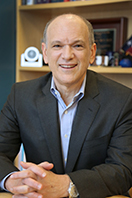
Message From the President: Neuroscience 2017 Demonstrates the Centrality of Global Collaboration

Neuroscience has become increasingly global in its aspirations and diverse in its collaborations over the past decade, helping the field to make significant progress in a relatively short amount of time. This momentum continues to propel us toward even more opportunities for advancements in everything from molecular profiling of individual cells and circuits to brain imaging techniques to novel therapies for neurodegenerative disorders.
Our ability to advance the understanding of the brain and nervous system requires incorporating numerous research perspectives, which necessitates reaching outside our own areas of focus — and even outside our field. This research could be taking place on the other side of the country, on the other side of the world, or in the lab next door. By committing to collaborations across institutions, fields, countries, and continents, and by embracing the spectacular interdisciplinary nature of modern neuroscience, we actively forge the strongest path forward for scientific progress.
As a member of the neuroscience community, you contribute a unique perspective to this inspirational mix of experience and knowledge, and I encourage you to both voice your ideas and listen to those of others. Through this dialogue and collaboration, the neuroscience community empowers itself to move toward solutions for our world’s most devastating public health problems. It is our responsibility to each other — and to our family, friends, and neighbors — to work together to realize these solutions.
The Global Nature of the Annual Meeting
SfN’s annual meeting is a mecca for global collaboration. It gives attendees unparalleled access to research findings, fellow scientists, and evolving technologies. While there is plenty of opportunity to network with colleagues in your specific area of research and from your own country, you can also engage with peers in other disciplines and from around the world. In fact, more than 5,000 of the scientific abstracts submitted for Neuroscience 2017 came from 78 different countries, not including the U.S.
Diversity is equally represented in the scientific sessions at Neuroscience 2017, which include lectures by world-renowned scientists who hail from places as varied as China, Denmark, England, Germany, India, Japan, and Lebanon. This diverse pool of presenters offers attendees the chance to listen to and interact with people they might not otherwise meet and who could spark ideas and change lives. This is in part why SfN works so hard to increase participation of scientists from a diversity of backgrounds — to prompt innovation that could transform our world.
In addition, during the annual meeting, SfN leaders meet with their counterparts of international partner organizations such as the Federation of European Neuroscience Societies (FENS) and the International Brain Research Organization (IBRO), as well as neuroscience leaders in Canada and Mexico, to plan strategies for supporting the neuroscience community with coordinated advocacy efforts and other activities to benefit the field. And when the annual meeting takes place in Washington, DC, as it does this year, SfN reaches out to the embassies of countries with scientists attending the meeting. We let them know that citizens of their country will be presenting their latest research at the meeting and encourage them to connect with their scientists and attend their scientific sessions.
Building Collaborations
SfN’s annual meeting is the ideal place to build interdisciplinary collaborations among the best and brightest minds across the entire spectrum of science. As you prepare for Neuroscience 2017, take note of the successful international scientific efforts already underway and think about how we can work together to enhance these projects or create new ones that would benefit the global scientific community.
Neuroscientists and researchers in a wide range of related fields have banded together in several international consortia powered by the collective resources of their constituent nations. For instance, the International Human Epigenome Consortium provides free access for the entire research community to high-resolution reference human epigenome maps for normal and diseased cell types. The consortium receives contributions and support from 11 countries, in addition to the European Union. Another promising collaboration is Enhancing Neuro Imaging Genetics through Meta Analysis (ENIGMA), which brings together researchers in imaging genomics, neurology, and psychiatry to understand brain structure, function, and disease. Since 2009, ENIGMA has mobilized 300 scientists from 185 institutions in 33 countries.
Using these types of collaborations as models, I urge all of you attending Neuroscience 2017 to talk to as many people as you can at the meeting and to approach every conversation as an opportunity for a collaborative initiative that could advance neuroscience and the ways in which it influences the human condition. I’ve spoken a lot recently about the interdisciplinary nature of our field, and it is only logical that we should concentrate the skills of scientists in all fields toward achieving our common goals.
Brain Diseases: The Problem of Our Time
There is a universal recognition that brain diseases are the greatest health problem of our time, as evidenced by the numerous national and global neuroscience initiatives investing significant time, effort, and funds into studying the brain, such as the BRAIN Initiative in the U.S., and the Human Brain Project in Europe. Individually, these efforts are critical for advancing our foundational knowledge of how the brain works, but if we as scientists share our discoveries, we will move the field forward even more quickly than we are now. Science is a unifying force that knows no borders, and at times when the world is troubled, science can be a means for improving global communication as people from all countries come together for collaborations and events such as SfN’s annual meeting. I hope to see you all in a few weeks’ time in Washington, DC, so that you may contribute your perspective — no matter your field, research interests, or country — to the discussions with thousands of your colleagues from around the world that will advance the progress of neuroscience.

















